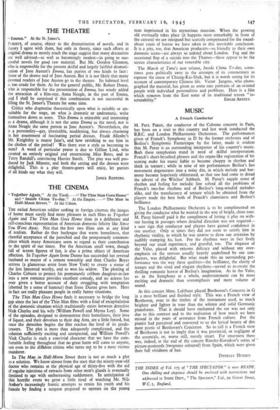THE CINEMA
" Together Again." At the Tivoli.--" The Thin Man Goes Home" and " Inside China To-day." At the Empire.—" The Man in Half-Moon Street." At the Cdeon.
THE exiled American soldier seeking in foreign cinemas the images of home must surely find more pleasure in such films as Together Again and The Thin Man Goes Home than in a deliberate and self-conscious representation of American domestic felicity like Since You Went Away. Not that the first two films aim at any kind of realism. Rather do they burlesque that warm homeliness, that cheerful acceptance of the parochial and the prosperously common- place which many Americans seem to regard as their contribution to the spirit of our times. For the American small town, though full of screen figures of fun, is also a prime object of American affection. In Together Again Irene Dunne bas succeeded her revered husband as mayor of a remote township and then Charles Boyer arrives (a glamorous artist from New York) to create a statue of the late lamented worthy, and to woo his widow. The plotting of Charles Coburn to project his prematurely celibate daughter-in-law into a new romance provides excellent comedy, and no actress has ever given a better account of duty struggling with temptation (abetted by a sense of humour) than Irene Dunne gives here. Here in fact are really pleasant people in really funny situations.
The Thin Man Goes Home fords it necessary to bridge the long gap since the last of the Thin Man films with a kind of recapitulation of the domestic situation which traditionally exists between detective Nick Charles and his wife (William Powell and Myrna Loy). Some of the episodes, designed to demonstrate their homeliness, their love of liquor, and their devotion to their dog Asta, are a little forced, but once the detection begins the film reaches the level of its prede- cessors. The plot is more than adequately complicated, and the solution sufficiently exciting and unexpected, and William Powell's Nick Charles is such a convivial character that we have the com- fortable feeling throughout that no great harm will come to anyone, not even to the diffident citizen who turns out to be a most vicious murderer.
In The Matt in Half-Moon Street there is not so much a plot as a solution. We know almost from the start that the ninety-year-old doctor who remains at the physical age of thirty-five with the aid of regular injections of extracts from other men's glands is eventually destined to age with embarrassing suddenness. In anticipation of this horrific event we grow a little tired of watching Mr. Nils Asther's increasingly frantic attempts to retain his youth and his fiancee by finding a surgeon prepared to operate on the young
man imprisoned in his mysterious mansion. When the growing old eventually takes place (it happens most remarkably in front of the camera) we are intrigued but scarcely compensated for the round- about route of horror we have taken to this inevitable conclusion. It is a pity, too, that American producers—so. friendly to their own domestic scene—are always so unkind about London. Fog and the occasional flop of a suicide into the Thames—these appear to be the screen characteristics of our venerable city.
The March of Time's new release, Inside China To-day, some- times goes politically awry in the attempts of its commentary to espouse the cause of Chiang-Kai-Shek, but it is worth seeing for its account of contemporary Chinese life. Victor Jurgens, who photo- graphed the material, has given us some rare portraits of an oriental people with individual personalities and problems. Here is a film which removes from the East some of its traditional screen "in-


























 Previous page
Previous page